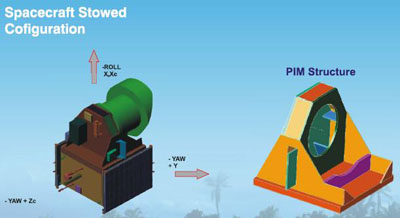The Megha-Tropiques system is composed of a mini-satellite developed jointly by France and India, which includes:
- a platform derived from the Indian IRS platform
- a set of four payloads
- MADRAS, developed jointly by CNES and ISRO
- SAPHIR, provided by CNES
- SCARAB, provided by CNES
- a radio-occulation receiver GPS, provided by ISRO
MADRAS is a conical scanning microwave imager: the incidence has to be constant to take advantage of the polarization information. The spot size is always the same but the scan track follows a circle arc. SAPHIR and SCARAB are cross track scanning radiometers: the scan track is perpendicular to the satellite track and the spots enlarge with the scan angle.
Megha-Tropiques Spacecraft consists of two major modules: a cuboid spacecraft bus derived from the IRS heritage; and the Payload Instrument Module (PIM), housing the payloads and associated elements. The spacecraft deployment mechanism consists of solar array deployment after separation from the launcher; a MADRAS hold-down release mechanism; and the MADRAS scan mechanism. Thermal control system with Optical Solar Reflectors and the Multi-Layer Insulation (MLI) blankets.

A centralised Bus Management Unit (BMU) supports all the functions of the Attitude Orientation Control System (AOCS), sensor processing, TT&C handling, thermal management, onboard data storage logistics, and the Ampere Hour Meter processing.




